Indesit WISL 1000 OT User Manual [ru]

Instructions for use
GB |
|
I |
|
CZ |
|
|
|
|
|
|
|
English,1 |
Italiano,13 |
Èeský,25 |
|||
SK |
|
HU |
|
|
CIS |
|
|
|
|
|
|
|
|
Slovenský,37 |
|
|
|
|
|
|
Magyar,49 |
РУССКИЙ,61 |
|||||
WISL 1000 OT
WASHING MACHINE
Contents
GB
Installation, 2-3
Unpacking and levelling Electric and water connections Technical details
Washing machine description, 4-5
Detergent dispenser Control panel
Running a wash cycle, 6
Programme table, 7
Detergents and laundry, 8
Preparing your laundry
Special items
Load-balancing system
Precautions and advice, 9
General safety Disposal
Saving energy and respecting the environment
Care and maintenance, 10
Cutting off the water or electricity supply
Cleaning your appliance
Cleaning the detergent dispenser
Caring for your appliance door and drum
Cleaning the pump
Checking the water inlet hose
Troubleshooting, 11
Service, 12
Before calling for Assistance
1
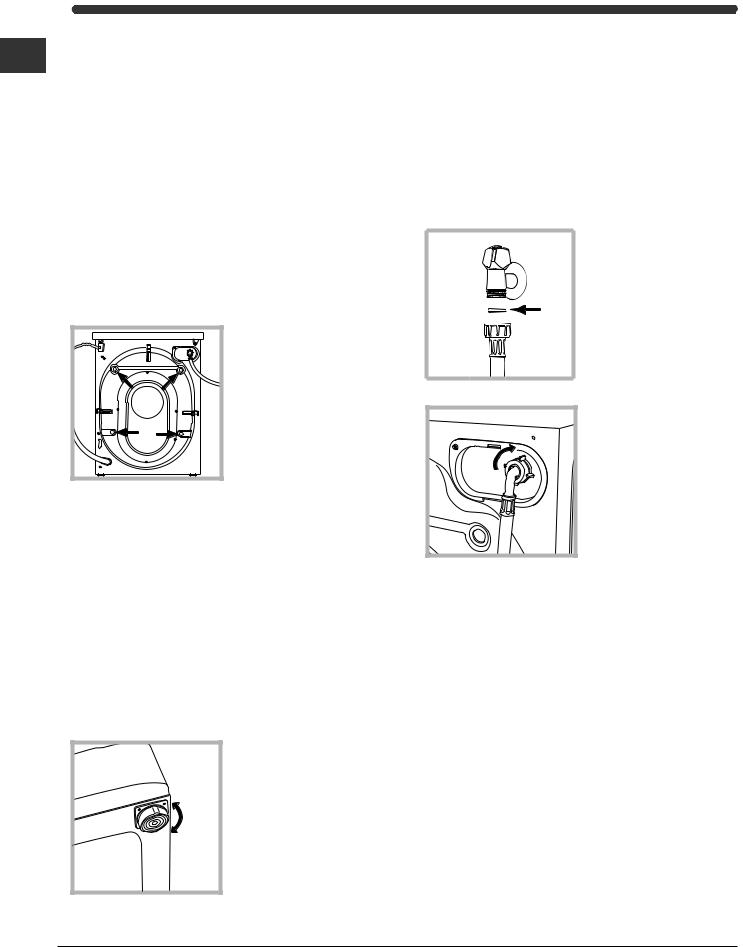
Installation
Keep this instruction manual in a safe place for GB future reference. Should the appliance be sold,
transferred or moved, make sure the instruction manual accompanies the washing machine to inform the new owner as to its operation and features.
Read these instructions carefully: they contain vital information on installation, use and safety.
Unpacking and levelling
Unpacking
1.Unpack the washing machine.
2.Check whether the washing machine has been damaged during transport. If this is the case, do not install it and contact your retailer.
3. Remove the 4 protective screws and the rubber washer with the respective spacer, situated on the rear of the appliance (see figure).
4.Seal the gaps using the plastic plugs provided.
5.Keep all the parts: you will need them again if the washing machine needs to be moved to another location.
Packaging materials are not children's toys.
Levelling
Your machine may make a considerable amount of noise if the two front feet have not been adjusted correctly.
1. Install the washing machine on a flat sturdy floor, without resting it up against walls, furniture cabinets or other.
2. If the floor is not perfectly level, compensate for any unevenness
by tightening or
loosening the adjustable
front feet (see figure); the angle of inclination, measured according to the worktop, must not exceed 2°.
Levelling your appliance correctly will provide it with stability and avoid any vibrations, noise and shifting during operation. If it is placed on a fitted or loose carpet, adjust the feet in such a way as to allow enough room for ventilation beneath the washing machine.
Electric and water connections
Connecting the water inlet hose
1. Insert seal A into the end of the inlet hose and screw the latter onto a cold water tap with a 3/4 gas threaded
A |
mouth (see figure). |
|
|
|
Before making the |
|
connection, allow the |
|
water to run freely until |
|
it is perfectly clear. |
|
2. Connect the other end |
|
of the water inlet hose to |
|
the washing machine, |
|
screwing it onto the |
|
appliance's cold water |
|
inlet, situated on the top |
|
right-hand side on the |
|
rear of the appliance |
|
(see figure). |
3. Make sure there are no kinks or bends in the hose.
The water pressure at the tap must be within the values indicated in the Technical details table
(on the next page).
If the water inlet hose is not long enough, contact a specialist store or an authorised serviceman.
2
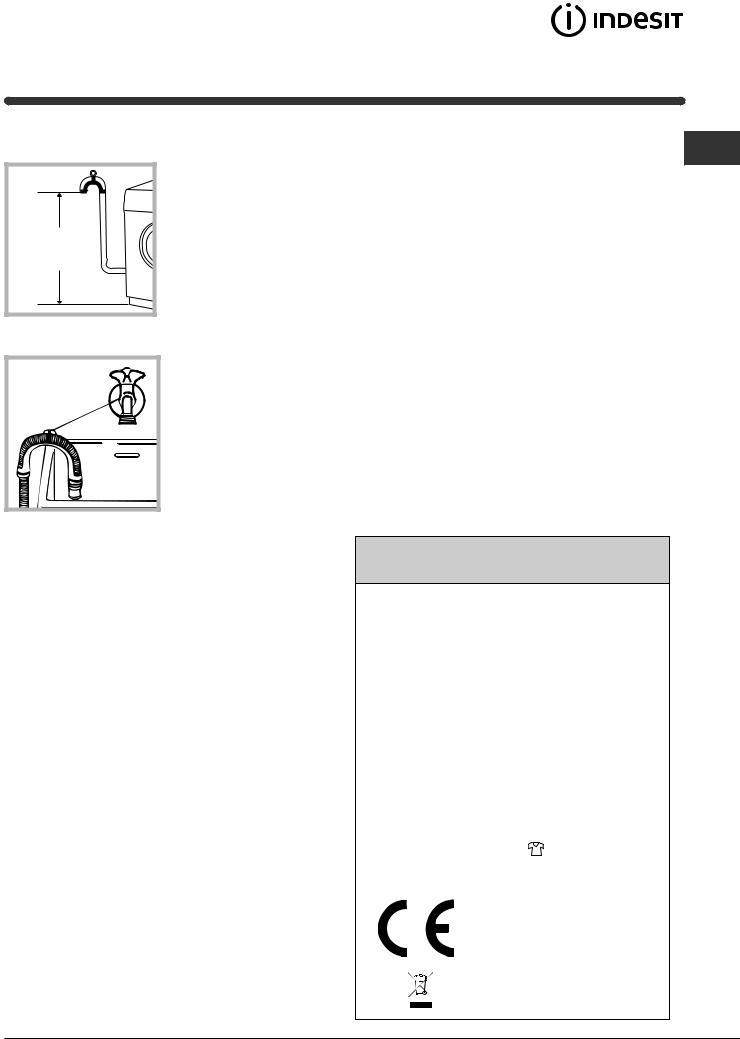
Connecting the drain hose
65 - 100 cm |
Connect the drain hose, without bending it, to a draining duct or a wall drain situated between 65 and 100 cm from the floor;
alternatively, place it over the edge of a basin, sink or tub, fastening the duct supplied to the tap (see figure). The free end of the hose should not be underwater.
Do not use extensions or multiple sockets.
GB
The power supply cable must never be bent or dangerously compressed.
The power supply cable must only be replaced by an authorised serviceman.
Warning! The company denies all liability if and when these norms are not respected.
We advise against the use of hose extensions; in case of absolute need, the extension must have the same diameter as the original hose and must not exceed 150 cm in length.
Electric connection
Before plugging the appliance into the mains socket, make sure that:
•the socket is earthed and in compliance with the applicable law;
•the socket is able to sustain the appliance's maximum power load indicated in the Technical details table (on the right);
•the supply voltage is included within the values i ndicated on the Technical details table
(on the right);
•the socket is compatible with the washing machine's plug. If this is not the case, replace the socket or the plug.
The washing machine should not be installed in an outdoor environment, not even when the area is sheltered, because it may be very dangerous to leave it exposed to rain and thunderstorms.
When the washing machine is installed, the mains socket must be within easy reach.
Technical details
Model |
WISL 1000 OT |
|
|
|
|
|
59.5 cm wide |
|
Dimensions |
85 cm high |
|
|
40 cm deep |
|
|
|
|
Capacity |
from 1 to 4,5 kg |
|
|
|
|
Electric |
voltage 220-230 Volts 50 Hz |
|
connections |
maximum absorbed power 1850 W |
|
|
|
|
Water |
maximum pressure 1 MPa (10 bar) |
|
minimum pressure 0.05 MPa (0.5 bar) |
||
connections |
||
drum capacity 40 litres |
||
|
||
|
|
|
Spin speed |
up to 1000 rpm |
|
|
|
|
Control |
|
|
programmes |
programme ; TIMER knob "auto"; |
|
according to |
run with a load of 4,5 kg. |
|
IEC456 directive |
|
|
|
|
|
|
This appliance is compliant with the |
|
|
following European Community |
|
|
Directives: |
|
|
- 73/23/CEE of 19/02/73 (Low |
|
|
Voltage) and subsequent amendments |
|
|
- 89/336/CEE of 03/05/89 |
|
|
(Electromagnetic Compatibility) and |
|
|
subsequent amendments |
|
|
- 2002/96/CE |
3
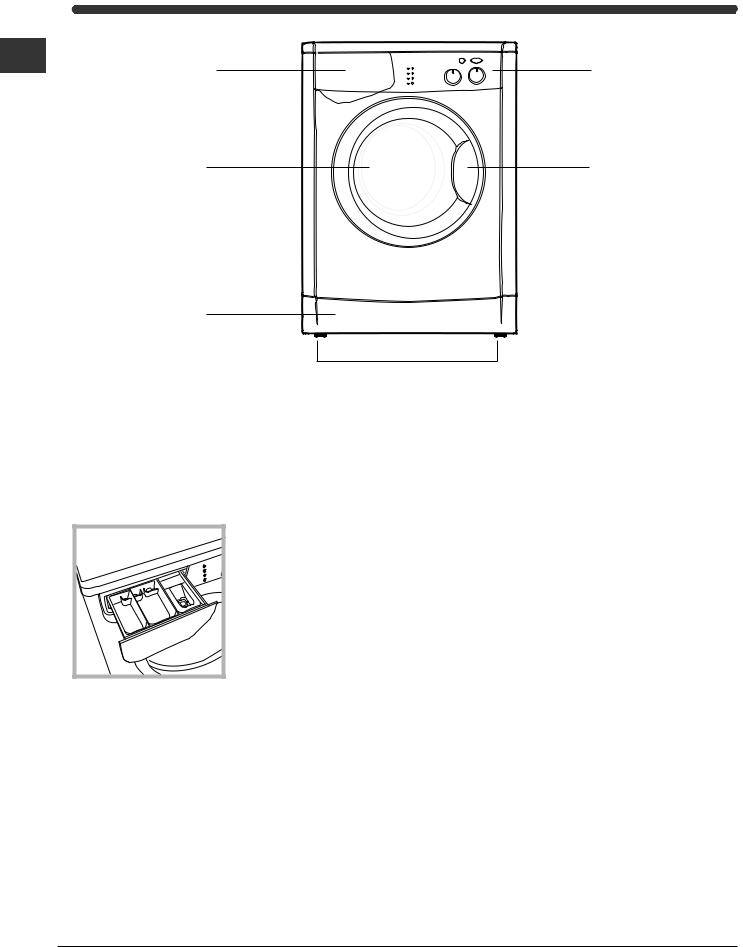
Washing machine description
GB |
DETERGENT |
CONTROL |
|
||
|
DISPENSER |
|
|
PANEL |
|
|
|
DOOR |
DOOR |
|
HANDLE |
||
|
KICKSTRIP
ADJUSTABLE FEET
Detergent dispenser
Good washing results also depend on the correct dose of detergent: adding too much detergent won't necessarily make for a more efficient wash, and may in fact cause build up on the interior of your appliance and even pollute the environment.
|
3 |
1 |
2 |
Open up the detergent dispenser and pour in the detergent and fabric softener, as follows.
compartment 1: Detergent for pre-wash (powder)
Pre-wash detergent should only be used with the sportswear programme  , while setting the timer knob to the "auto" position or to one of the "3h" to "24h" positions (see “Detergents and laundry”). compartment 2: Detergent for the wash cycle (powder or liquid)
, while setting the timer knob to the "auto" position or to one of the "3h" to "24h" positions (see “Detergents and laundry”). compartment 2: Detergent for the wash cycle (powder or liquid)
Liquid detergent should only be poured in immediately prior to the wash cycle start. compartment 3: Additives (fabric softeners, etc.)
The fabric softener should not overflow from the grid.
Do not use hand wash detergent because it may form too much foam.
4

Control panel
GB
Indicator |
ON-OFF/ |
|
|
|
|
|
|
|
|
||||
lights |
DOOR |
|
|
|
ON-OFF |
|
|
||||||
|
|
LOCK |
|
|
|
|
|
|
|
|
|
Button |
|
|
|
indicator light |
|
|
|
|
|
|
|
|
|
|
|
|
|
|
|
|
|
|
|
|
|
|
|
|
|
|
|
|
|
|
|
|
|
|
TIMER |
|
|
|
Detergent dispenser |
|
Knob |
|
||
|
START/CANCEL |
|
|
Button |
|
|
PROGRAMMES |
|
|
Knob |
|
Detergent dispenser: to add detergent and fabric softener (see “Washing machine description”).
Indicator lights: show that the programme has started and give an indication of the time remaining until the end of the programme (see “Running a wash cycle”).
PROGRAMME knob: to select the wash programmes. The knob stays still during the cycle.
START/CANCEL button: starts the cycle after the programme and required time have been set.
To cancel the programme and set a different one, press and hold the button for at least 3 seconds.
ON-OFF/DOOR LOCK indicator light:
If the indicator light is switched on, this shows that the door has been locked in order to prevent it being opened accidentally; to avoid damaging the machine, wait until the indicator light begins to flash after the cycle has finished before opening the door. The waiting time is approximately 2 minutes.
If the ON-OFF/DOOR LOCK indicator light flashes extremely rapidly it has experienced a problem (see “Troubleshooting”).
ON/OFF button: to turn the washing machine on and off.
TIMER knob: sets the required duration of the programme.
In the "auto" position the duration is controlled automatically by the machine.
5
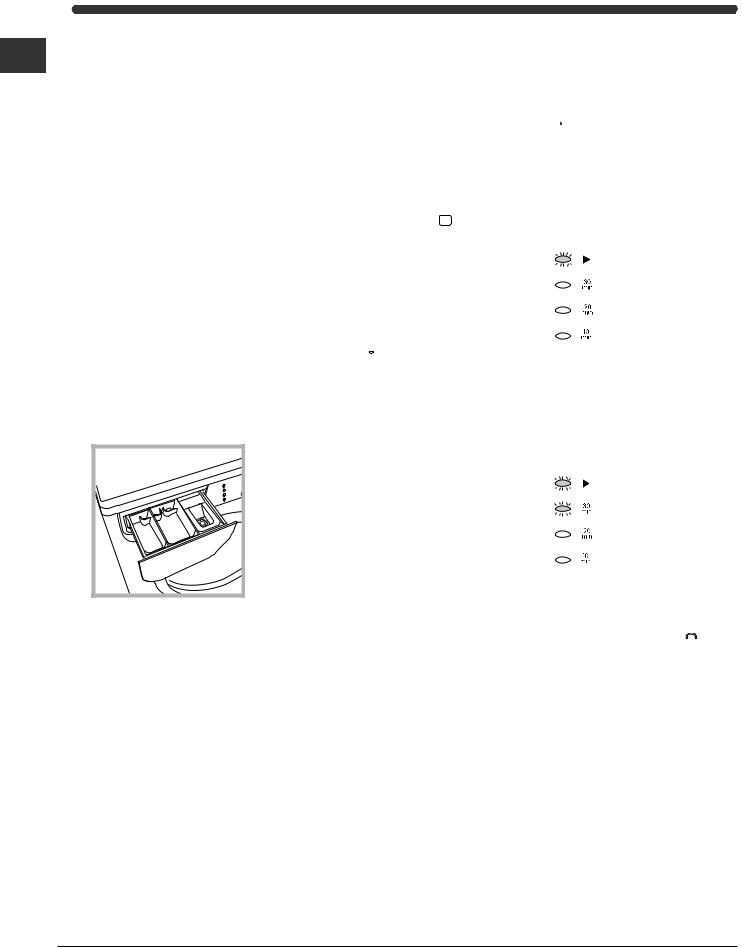
Running a wash cycle
Note: After installing the machine and before using GB it for the first time, run an empty wash cycle using
detergent, setting the  programme and ensuring the timer knob is in the "auto" position.
programme and ensuring the timer knob is in the "auto" position.
1.Switch the washing machine on by pressing ON/OFF button  . All the LEDS will light up for a few seconds and the ON-OFF/DOOR LOCK indicator light
. All the LEDS will light up for a few seconds and the ON-OFF/DOOR LOCK indicator light will begin to flash.
will begin to flash.
2.LOADING LAUNDRY. Open the door. Load the laundry, making sure that the maximum load quantity indicated in the table of programmes (below) is not exceeded.
3.MEASURING OUT DETERGENT/WASHING ADDITIVES Remove the drawer completely and pour the detergent into the compartment marked with the number 2. If required, pour fabric softener and other additives into the compartment marked with the number 3. The softener must not rise above
the level of the grille. If you wish to run the
washing programme especially for sportswear  (by setting the timer knob to "auto" or to one of the positions between "3h and 24h" - see “Detergents and laundry”), it is also possible to use powder detergent in compartment 1 for the pre-wash phase.
(by setting the timer knob to "auto" or to one of the positions between "3h and 24h" - see “Detergents and laundry”), it is also possible to use powder detergent in compartment 1 for the pre-wash phase.
|
3 |
1 |
2 |
4.CLOSE THE DOOR.
5.SELECT THE WASH FABRIC by turning the PROGRAMME KNOB right or left until the correct fabric or the "Rinse" programme is selected.
6.SET THE WASHING END TIME by turning the TIMER KNOB right or left.
The following settings may be used:
-Positions "30 min - 45 min - 60 min": by selecting one of these times, the duration of the programme is set.
-Positions between "3h" and "24h": by selecting one of these times the user selects the number of hours after which the programme should finish. The effective duration of the wash is equivalent to the "auto" cycle duration (see table of programmes below), but the machine will delay the start of the cycle automatically to ensure it ends within the set time period.
- Whenever it is not necessary to set a specific time for washing to end, select the "AUTO" position: the machine automatically controls the duration of the programme, based on the fabric selected (see table of programmes below).
Regardless of the position selected for the TIMER KNOB, the "Rinse"  programme lasts 15 minutes and begins as soon as the START/ CANCEL
programme lasts 15 minutes and begins as soon as the START/ CANCEL  button is pressed.
button is pressed.
7. START THE PROGRAMME by pressing the START/CANCEL  button. The "on-off/door lock"
button. The "on-off/door lock"  and "programme in progress"
and "programme in progress"  indicator lights will illuminate and remain lit constantly.
indicator lights will illuminate and remain lit constantly.
During the cycle, the indicator lights provide information relating to the amount of time remaining until the end of the programme. When there are 30, 20 and 10 minutes respectively remaining until the end of the
programme, the corresponding indicator lights will illuminate.
8.PROGRAMME END
At the end of the wash programme, all the
indicator lights will switch off. Wait for the door to become unlocked (the "on-off/door lock"  indicator light flashes), remove the laundry and leave the door ajar in order to let the drum dry
indicator light flashes), remove the laundry and leave the door ajar in order to let the drum dry
out. Switch off the machine by pressing the ON/ OFF  button.
button.
6

Programme table
|
|
|
|
|
|
|
|
|
|
|
|
|
|
|
|
|
|
|
|
|
|
|
|
|
Nature of fabrics |
Program- |
Times |
Maximum |
Maximum |
Wash cycle description |
|
|
|
||
|
|
|
|
||||||||
|
and soiling |
mes |
Load (kg) |
temperature |
|
GB |
|||||
|
|
|
|
|
|
|
|
|
|
|
|
|
|
|
|
|
auto (125 min.) |
4,5 |
60° |
|
|
|
|
|
|
|
|
|
|
|
|
|
|
|
|
|
|
|
|
|
30 min. |
3 |
40° |
|
|
|
|
|
White cotton |
|
|
|
45 min. |
3 |
60° |
Wash, rinse, intermediate and final spins |
|
|
|
|
|
|
|
|
60 min. |
3 |
60° |
|
|
|
|
|
|
|
|
|
3h - 24h |
4,5 |
60° |
|
|
|
|
|
|
|
|
|
|
|
|
|
|
|
|
|
|
|
|
|
auto (70 min.) |
4,5 |
|
|
|
|
|
|
|
|
|
|
|
|
|
|
|
|
|
|
|
|
|
|
30 min. |
3 |
|
|
|
|
|
|
Coloured cotton |
|
|
|
45 min. |
3 |
40° |
Wash, rinse, intermediate and final spins |
|
|
|
|
|
|
|
|
60 min. |
3 |
|
|
|
|
|
|
|
|
|
|
3h - 24h |
4,5 |
|
|
|
|
|
|
|
|
|
|
|
|
|
|
|
|
|
|
|
|
|
|
auto (60 min.) |
4,5 |
|
|
|
|
|
|
|
|
|
|
|
|
|
|
|
|
|
|
|
|
|
|
30 min. |
3 |
|
|
|
|
|
|
Dark/delicate cotton |
|
|
|
45 min. |
3 |
30° |
Wash, rinse, intermediate and final spins |
|
|
|
|
|
|
|
|
60 min. |
3 |
|
|
|
|
|
|
|
|
|
|
3h - 24h |
4,5 |
|
|
|
|
|
|
|
|
|
|
|
|
|
|
|
|
|
|
|
|
|
|
auto (60 min.) |
2,5 |
|
|
|
|
|
|
|
|
|
|
|
|
|
|
|
|
|
|
|
|
|
|
30 min. |
1,5 |
|
|
|
|
|
|
Synthetics |
|
|
|
45 min. |
2,5 |
40° |
Wash, rinse, gentle spin |
|
|
|
|
|
|
|
|
60 min. |
2,5 |
|
|
|
|
|
|
|
|
|
|
3h - 24h |
2,5 |
|
|
|
|
|
|
|
|
|
|
|
|
|
|
|
|
|
|
|
|
|
|
auto (60 min.) |
1 |
|
|
|
|
|
|
|
|
|
|
|
|
|
|
|
|
|
|
|
|
|
|
30 min. |
1 |
|
|
|
|
|
|
Wool |
|
|
|
45 min. |
1 |
40° |
Wash, rinse, gentle spin |
|
|
|
|
|
|
|
|
60 min. |
1 |
|
|
|
|
|
|
|
|
|
|
3h - 24h |
1 |
|
|
|
|
|
|
|
|
|
|
|
|
|
|
|
|
|
|
|
|
|
|
auto (60 min.) |
1 |
|
|
|
|
|
|
|
|
|
|
|
|
|
|
|
|
|
|
|
|
|
|
30 min. |
1 |
|
|
|
|
|
|
Delicates |
|
|
|
45 min. |
1 |
30° |
Wash, rinse, drain |
|
|
|
|
|
|
|
|
60 min. |
1 |
|
|
|
|
|
|
|
|
|
|
3h - 24h |
1 |
|
|
|
|
|
|
|
|
|
|
|
|
|
|
|
|
|
|
|
|
|
|
auto (60 min.) |
1,5 |
|
|
|
|
|
|
|
|
|
|
|
|
|
|
|
|
|
|
|
|
|
|
30 min. |
1,5 |
|
|
|
|
|
|
|
|
|
|
|
|
|
|
|
||
|
Special Sport |
|
|
|
45 min. |
1,5 |
30° |
Prewash, wash, rinse, intermediate and final spins |
|
|
|
|
|
|
|
|
|
|
|||||
|
|
|
|
|
60 min. |
1,5 |
|
|
|
|
|
|
|
|
|
|
3h - 24h |
1,5 |
|
|
|
|
|
|
|
|
|
|
|
|
|
|
|
|
|
|
Rinse |
|
|
|
* |
4,5 |
|
Rinse and spin |
|
|
|
|
|
|
|
|
|
|
|
|
|
|
|
* Note: regardless of the position of the "TIMER knob", the Rinse cycle begins immediately after the ON/CANCEL button is pressed, and lasts for 15 minutes.
Important:
-the quick wash programmes "30 min" and "45 min" (regardless of the type of fabric) are recommended for refreshing lightly soiled garments in a short time.
-the "60 min" programmes (regardless of the type of fabric) are recommended for washing lightly soiled garments.
-Wash times do not include the 2 minutes at the end of the cycle when the user must wait for the door to unlock.
7

Detergents and laundry
Preparing your laundry
GB
•Divide your laundry according to:
-the type of fabric/the symbol on the label.
-the colours: separate coloured garments from whites.
•Empty all pockets and check for loose buttons.
•Do not exceed the maximum load values shown in the "Programme table".
How much does your laundry weigh?
1sheet 400-500 g
1pillow case 150-200 g
1tablecloth 400-500 g
1bathrobe 900-1200 g
1towel 150-250 g
Special items
Curtains: fold curtains and place them in a pillow case or mesh bag. Wash them separately without exceeding half the appliance load. Use programme which excludes the spin cycle automatically.
Quilted coats and windbreakers: if they are padded with goose or duck down, they can be machine-washed. Turn the garments inside out and load a maximum of 3 kg, repeating the rinse cycle once or twice.
Wool: for best results, use a specific detergent, taking care not to exceed a load of 1 kg. Sportswear: use the "Special Sport" programme. It is possible to run an initial pre-wash phase, which is useful for removing soil or mud residues from the garments. To use this phase, pour powder detergent into compartment 1 of the detergent drawer (see “Washing machine description”).
programme. It is possible to run an initial pre-wash phase, which is useful for removing soil or mud residues from the garments. To use this phase, pour powder detergent into compartment 1 of the detergent drawer (see “Washing machine description”).
The pre-wash phase will not run if the timer knob is set to a duration between 30 minutes and 1 hour (inclusive).
Load-balancing system
To avoid excessive vibrations, before every spin cycle the machine distributes the load in a uniform manner by continuously rotating the drum at a speed which is slightly faster than the normal washing speed.
When, despite repeated attempts, the load is still not evenly distributed, the machine spins at a lower speed than the set frequency.
If the load is excessively unbalanced, the machine attempts to distribute it instead of spinning.
The balancing attempts may extend the total duration of the cycle, up to a maximum of 10 minutes.
8

Precautions and advice
The washing machine was designed and built in compliance with the applicable international safety regulations. The following information is provided for your safety and should consequently be read carefully.
the impact on human health and the environment.
The crossed out "wheeled bin" symbol on the GB product reminds you of your obligation, that when
you dispose of the appliance it must be separately collected.
General safety
•This appliance has been designed for nonprofessional, household use and its functions must not be changed.
•This washing machine should only be used by adults and in accordance with the instructions provided in this manual.
•Never touch the washing machine when barefoot or with wet or damp hands or feet.
•Do not pull on the power supply cable to unplug the appliance from the electricity socket. Pull the plug out yourself.
•Do not open the detergent dispenser while the appliance is in operation.
•Do not touch the drain water as it could reach very high temperatures.
•Never force the washing machine door: this could damage the safety lock mechanism designed to prevent any accidental openings.
•In the event of a malfunction, do not under any circumstances touch internal parts in order to attempt repairs.
•Always keep children well away from the appliance while in operation.
•The appliance door tends to get quite hot during the wash cycle.
•Should it have to be moved, proceed with the help of two or three people and handle it with the utmost care. Never try to do this alone, because the appliance is very heavy.
•Before loading your laundry into the washing machine, make sure the drum is empty.
Disposal
•Disposing of the packaging material:
observe local regulations, so the packaging can be re-used.
•The European Directive 2002/96/EC on Waste Electrical and Electronic Equipment, requires that old household electrical appliances must not be disposed of in the normal unsorted municipal waste stream. Old appliances must be collected separately in order to optimise the recovery and recycling of the materials they contain and reduce
Consumers should contact their local authority or retailer for information concerning the correct disposal of their old appliance.
Saving energy and respecting the environment
Environmentally-friendly technology
If you only see a little water through your appliance door, this is because thanks to the latest Indesit technology, your washing machine only needs less than half the amount of water to get the best results: an objective reached to respect the environment.
Saving on detergent, water, energy and time
•To avoid wasting resources, the washing machine should be used with a full load. A full load instead of two half loads allows you to save up to 50% on energy.
•Treating stains with a stain remover or leaving them to soak before washing will cut down the need to wash them at high temperatures.
•Use the correct quantity of detergent depending on the water hardness, how soiled the garments are and the amount of laundry you have, to avoid wastage and to protect the environment: despite being biodegradable, detergents do contain ingredients that alter the natural balance of the environment. In addition, avoid using fabric softener as much as possible.
•If you use your washing machine from late in the afternoon until the early hours of the morning, you will help reduce the electricity board's peak load.
9
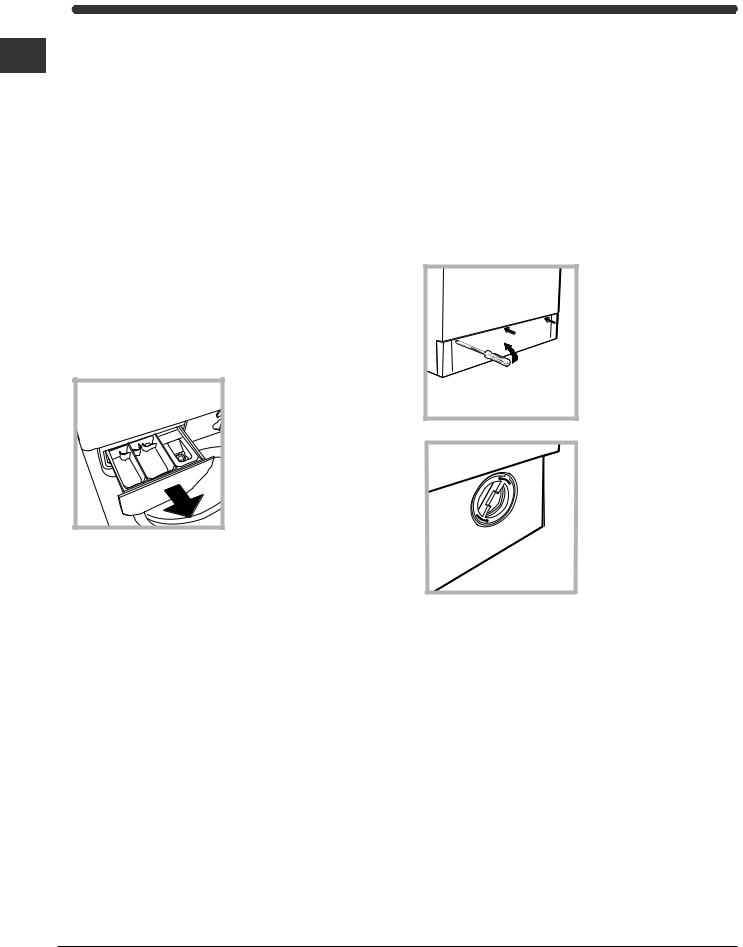
Care and maintenance
Cutting off the water or electricity GB supply
•Turn off the water tap after every wash. This will limit the wear of your appliance's water system and also prevent leaks.
•Unplug your appliance when cleaning it and during all maintenance operations.
Cleaning your appliance
The exterior and rubber parts of your appliance can be cleaned with a soft cloth soaked in lukewarm soapy water. Do not use solvents or abrasives.
Cleaning the detergent dispenser
Remove the dispenser by pulling it out (see figure).
Wash it under running water; this operation should be repeated frequently.
Caring for your appliance door and drum
•Always leave the appliance door ajar to prevent unpleasant odours from forming.
Cleaning the pump
The washing machine is fitted with a self-cleaning pump that does not require any maintenance. Sometimes, small items (such as coins or buttons) may fall into the pre-chamber that protects the pump, situated in the lower part of the same.
Make sure the wash cycle has ended and unplug the appliance.
To access the pre-chamber:
1. using a screwdriver, remove the cover panel on the lower front of the washing machine (see figure);
2. unscrew the lid rotating it anticlockwise (see figure): a little water may trickle out. This is perfectly normal;
3.clean the interior thoroughly;
4.screw the lid back on;
5.reposition the panel, making sure the hooks are securely in place before you push it onto the appliance.
Checking the water inlet hose
Check the water inlet hose at least once a year. If you see any cracks, replace it immediately: during the wash cycles, water pressure is very strong and a cracked hose could easily split open.
Never use hoses that have already been used.
10

Troubleshooting
Your washing machine could fail to work. Before calling for Assistance (see “Service”), make sure the problem
can't easily be solved by consulting the following list. |
GB |
|
Problem
The washing machine won't start.
The wash cycle won't start.
The washing machine fails to load water.
The washing machine continuously loads and unloads water.
The washing machine does not drain or spin.
The washing machine vibrates too much during the spin cycle.
The washing machine leaks.
The ON-OFF/DOOR LOCK indicator light flashes extremely rapidly.
There is too much foam.
Possible causes/Solution:
•The appliance is not plugged into the socket, or not enough to make contact.
•There has been a power failure.
•The appliance door is not shut properly.
•The ON/OFF button  has not been pressed.
has not been pressed.
• The START/CANCEL button |
has not been pressed. |
•The water tap is not turned on.
•A washing end time between "3h" and "24h" has been set (see “Running a wash cycle”).
•The water inlet hose is not connected to the tap.
•The hose is bent.
•The water tap is not turned on.
•There is a water shortage.
•The water pressure is insufficient.
•The START/CANCEL button  has not been pressed.
has not been pressed.
•The drain hose is not fitted between 65 and 100 cm from the floor (see “Installation”).
•The free end of the hose is underwater (see “Installation”).
•The wall drainage system doesn't have a breather pipe.
If the problem persists even after these checks, turn off the water tap, switch the appliance off and call for Assistance. If the dwelling is on one of the upper floors of a building, there may be drain trap problems causing the washing machine to load and unload water continuously. In order to avoid such an inconvenience, special anti-drain trap valves are available in shops.
•The drain hose is bent (see “Installation”).
•The drain duct is clogged.
•When the machine is installed, the locking screws for the oscillating assembly are still in place. Remove the screws (see “Installation”).
•The washing machine is not level (see “Installation”).
•The washing machine is closed in between furniture cabinets and the wall (see “Installation”).
•The water inlet hose is not screwed on correctly (see “Installation”).
•The detergent dispenser is obstructed (to clean it, see “Care and maintenance”).
•The drain hose is not secured properly (see “Installation”).
•This means there is a problem with the machine. Before calling Assistance, please follow the set of instructions below:
1.Switch off the machine by pressing the  button;
button;
2.Remove the plug connecting the appliance to the mains supply and wait for at least 40 seconds;
3.Place the plug back into the socket;
4.Switch on the machine by pressing the  button again;
button again;
5.If the problem is still evident after this process has been carried out, contact Assistance.
•The detergent is not suitable for machine washing (it should bear the definition "for washing machines" or "hand and machine wash", or the like).
•You used too much detergent.
11

Service
Before calling for Assistance:
GB |
• |
Check whether you can solve the problem on your own (see “Troubleshooting”); |
|
||
|
• |
Restart the programme to check whether the problem has been solved; |
|
• |
If this is not the case, contact an authorised Technical Service Centre on the telephone number |
|
|
provided on the guarantee certificate. |
|
|
If the machine has been installed or used incorrectly, you may be charged for the maintenance callout service. |
|
|
Always request the assistance of authorised servicemen. |
Notify the operator of:
•the type of problem;
•the appliance model (Mod.);
•the serial number (S/N).
This information can be found on the data plate situated on the rear of the washing machine.
12

Istruzioni per l’uso
|
|
|
LAVABIANCHERIA |
||
|
|
|
|
|
|
|
|
|
|
|
|
|
|
|
Sommario |
|
|
|
|
|
I |
||
|
|
|
|
|
|
|
|
|
Installazione, 14-15 |
|
|
|
I |
|
|
||
|
|
Disimballo e livellamento |
|||
|
|
|
Collegamenti idraulici ed elettrici |
||
|
|
|
|||
|
Italiano,1 |
Dati tecnici |
|||
WISL 1000 OT
Descrizione della macchina, 16-17
Cassetto dei detersivi Pannello di controllo
Come effettuare un ciclo di lavaggio, 18 Tabella dei programmi, 19
Detersivi e biancheria, 20
Preparare la biancheria
Capi particolari
Sistema bilanciamento del carico
Precauzioni e consigli, 21
Sicurezza generale
Smaltimento
Risparmiare e rispettare l’ambiente
Manutenzione e cura, 22
Escludere acqua e corrente elettrica Pulire la macchina
Pulire il cassetto dei detersivi Curare oblò e cestello
Pulire la pompa
Controllare il tubo di alimentazione dell’acqua
Anomalie e rimedi, 23
Assistenza, 24
Assistenza Attiva 7 giorni su 7
13
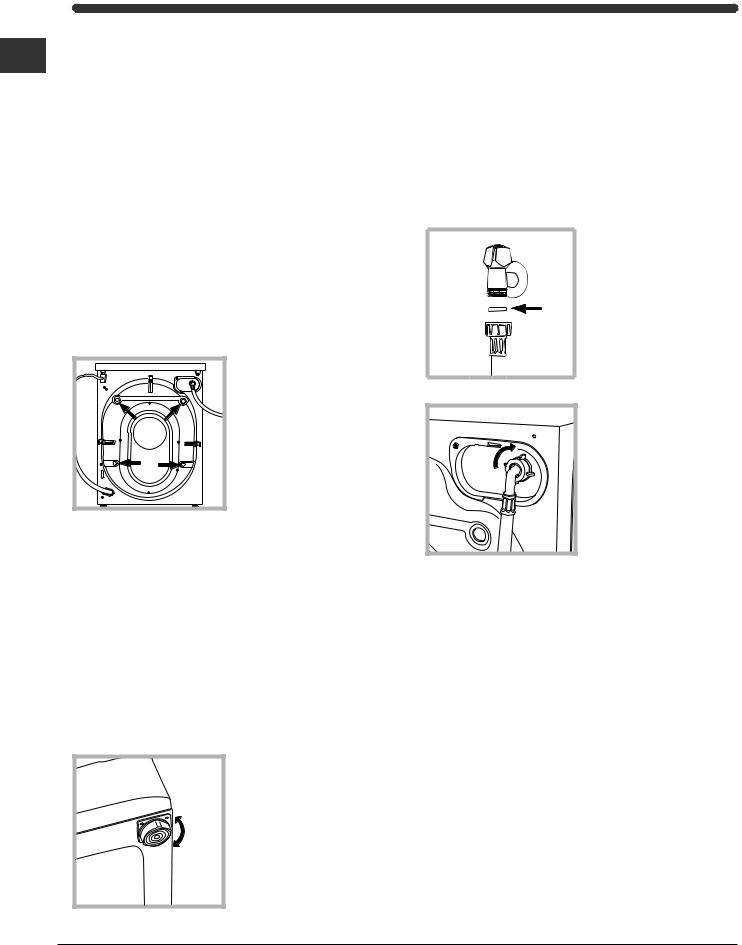
Installazione
È importante conservare questo libretto per poterlo I consultare in ogni momento. In caso di vendita, di
cessione o di trasloco, assicurarsi che resti insieme alla macchina per informare il nuovo proprietario sul funzionamento e sui relativi avvertimenti.
Leggere attentamente le istruzioni: ci sono importanti informazioni sull’installazione, sull’uso e sulla sicurezza.
Disimballo e livellamento
Disimballo
1.Disimballare la macchina.
2.Controllare che la macchina non abbia
subìto danni nel trasporto. Se fosse danneggiata non collegarla e contattare il rivenditore.
3. Rimuovere le 4 viti di protezione per il trasporto e il gommino con il relativo distanziale, posti nella parte posteriore
(vedi figura).
4.Chiudere i fori con i tappi di plastica in dotazione.
5.Conservare tutti i pezzi: qualora la macchina debba essere trasportata, dovranno essere rimontati.
Gli imballaggi non sono giocattoli per bambini.
Livellamento
La vostra macchina potrà essere rumorosa se i due piedini anteriori non sono stati regolati correttamente. 1. Installare la macchina su un pavimento piano e rigido, senza appoggiarla a muri, mobili o altro.
2. Se il pavimento non fosse perfettamente orizzontale, compensare le irregolarità svitando o avvitando i piedini anteriori (vedi figura); l’angolo di inclinazione, misurato sul piano di lavoro, non deve superare i 2°.
Un accurato livellamento dà stabilità alla macchina ed evita vibrazioni, rumori e spostamenti durante il funzionamento. In caso di moquette o di un tappeto, regolare i piedini in modo da conservare sotto la macchina uno spazio sufficiente per la ventilazione.
Collegamenti idraulici ed elettrici
Collegamento del tubo di alimentazione dell’acqua
1. Inserire la guarnizione A nell’estremità del tubo di alimentazione e avvitarlo a un rubinetto d’acqua fredda con
A |
bocca filettata da 3/4 |
|
|
|
gas (vedi figura). |
|
Prima di allacciare, far |
|
scorrere l’acqua finché |
|
non sia limpida. |
|
2. Collegare il tubo di |
|
alimentazione alla |
|
macchina |
|
avvitandolo all’apposita |
|
presa d’acqua, nella |
|
parte posteriore in alto |
|
a destra (vedi figura). |
3. Fare attenzione che nel tubo non ci siano né pieghe né strozzature.
La pressione idrica del rubinetto deve essere compresa nei valori della tabella Dati tecnici
(vedi pagina a fianco).
Se la lunghezza del tubo di alimentazione non fosse sufficiente, rivolgersi a un negozio specializzato o a un tecnico autorizzato.
14

Collegamento del tubo di scarico
65 - 100 cm |
Collegare il tubo di scarico, senza piegarlo, a una conduttura di scarico o a uno scarico a muro posti tra 65 e 100 cm da terra;
oppure appoggiarlo al bordo di un lavandino o di una vasca, legando la guida in dotazione al rubinetto (vedi figura). L’estremità libera del tubo di scarico non deve rimanere immersa nell’acqua.
Non usare prolunghe e multiple.
I
Il cavo non deve subire piegature o compressioni.
Il cavo di alimentazione deve essere sostituito solo da tecnici autorizzati.
Attenzione! L’azienda declina ogni responsabilità qualora queste norme non vengano rispettate.
È sconsigliato usare tubi di prolunga; se indispensabile, la prolunga deve avere lo stesso diametro del tubo originale e non superare i 150 cm.
Collegamento elettrico
Prima di inserire la spina nella presa della corrente, accertarsi che:
•la presa abbia la messa a terra e sia a norma di legge;
•la presa sia in grado di sopportare il carico massimo di potenza della macchina, indicato nella tabella Dati tecnici (vedi a fianco);
•la tensione di alimentazione sia compresa nei valori indicati nella tabella Dati tecnici (vedi a fianco);
•la presa sia compatibile con la spina della macchina. In caso contrario sostituire la
presa o la spina.
La macchina non va installata all’aperto, nemmeno se lo spazio è riparato, perché è molto pericoloso lasciarla esposta a pioggia e temporali.
A macchina installata, la presa della corrente deve essere facilmente raggiungibile.
Dati tecnici
Modello |
WISL 1000 OT |
|
|
|
|
|
larghezza cm 59,5 |
|
Dimensioni |
altezza cm 85 |
|
|
profondità cm 40 |
|
|
|
|
Capacità |
da 1 a 4,5 kg |
|
|
|
|
Collegamenti |
tensione a 220/230 Volt 50 Hz |
|
elettrici |
potenza massima assorbita 1850 W |
|
|
|
|
Collegamenti |
pressione massima 1 MPa (10 bar) |
|
pressione minima 0,05 MPa (0,5 bar) |
||
idrici |
||
capacità del cesto 40 litri |
||
|
||
|
|
|
Velocità di |
sino a 1000 giri al minuto |
|
centrifuga |
||
|
||
|
|
|
Programmi di |
Programma ; Tempi "auto"; |
|
controllo secondo |
||
effettuato con 4,5 kg di carico. |
||
la norma IEC456 |
||
|
||
|
|
|
|
Questa apparecchiatura è conforme |
|
|
alle seguenti Direttive Comunitarie: |
|
|
- 73/23/CEE del 19/02/73 (Bassa |
|
|
Tensione) e successive modificazioni |
|
|
- 89/336/CEE del 03/05/89 |
|
|
(Compatibilità Elettromagnetica) e |
|
|
successive modificazioni |
|
|
- 2002/96/CE |
15

Descrizione della macchina
I
CASSETTO |
PANNELLO |
DETERSIVI |
COMANDI |
OBLÒ |
MANIGLIA |
|
OBLÒ |
||
|
ZOCCOLO
PIEDINI REGOLABILI
Cassetto dei detersivi
Il buon risultato del lavaggio dipende anche dal corretto dosaggio del detersivo: eccedendo non si lava in modo più efficace e si contribuisce a incrostare le parti interne della macchina e a inquinare l’ambiente.
|
3 |
1 |
2 |
Estrarre il cassetto dei detersivi e inserire il detersivo o l’additivo come segue.
vaschetta 1: Detersivo per prelavaggio (in polvere)
Il detersivo per prelavaggio va utilizzato esclusivamente con il programma dedicato all'abbigliamento sportivo  , impostando la manopola tempi sulla posizione “auto” o su una delle posizioni da “3h a
, impostando la manopola tempi sulla posizione “auto” o su una delle posizioni da “3h a
24h” (vedi “Detersivi e biancheria”). vaschetta 2: Detersivo per lavaggio (in polvere o liquido)
Il detersivo liquido va versato solo prima dell’avvio. vaschetta 3: Additivi (ammorbidente, ecc.)
L’ammorbidente non deve fuoriuscire dalla griglia.
Non usare detersivi per il lavaggio a mano, perché formano troppa schiuma.
16
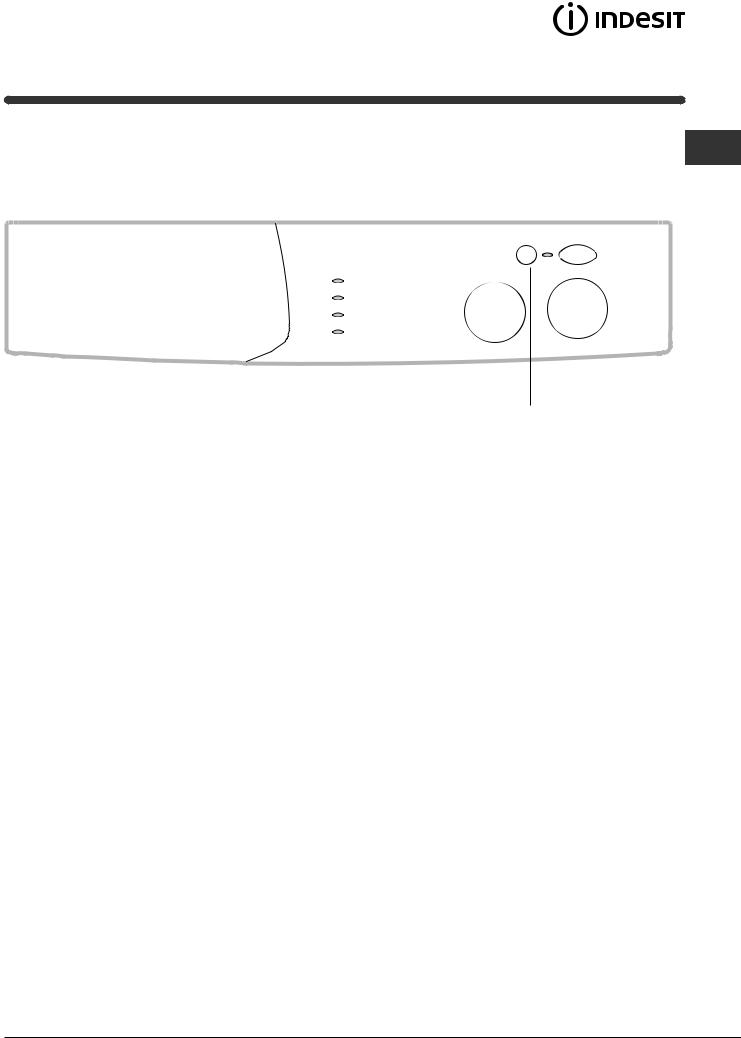
Pannello di controllo
I
Spie |
Spia ACCENSIONE/ |
|||
|
|
OBLÒ BLOCCATO Pulsante |
||
|
|
|||
|
|
|
|
ACCENSIONE/ |
|
|
|
|
|
|
|
|
|
SPEGNIMENTO |
|
|
|
|
|
|
|
|
|
|
|
Cassetto dei detersivi |
|
|
Manopola |
|
|
|
||
|
|
|
|
TEMPI |
|
|
|
Pulsante |
|
|
|
|
AVVIO/ANNULLA |
|
|
|
|
|
|
|
|
Manopola |
||
|
|
PROGRAMMI |
||
Cassetto dei detersivi: per caricare detersivi e |
Pulsante ACCENSIONE/SPEGNIMENTO: per |
|||
additivi (vedi “Descrizione della macchina”). |
accendere e spegnere la macchina. |
|||
Spie: indicano l’inizio del programma e il tempo |
Manopola TEMPI: per impostare dopo quanto tempo |
|||
rimanente alla fine (vedi “Come effettuare un ciclo di |
il programma dovrà terminare. |
|||
lavaggio”). |
In posizione “auto” la durata del programma è |
|||
|
|
gestita automaticamente dalla macchina. |
||
Manopola PROGRAMMI: per impostare i programmi |
|
|
|
|
(vedi “Tabella dei programmi”). |
|
|
|
|
Durante il programma la manopola resta ferma. |
|
|
|
|
Pulsante AVVIO/ANNULLA: per avviare il ciclo |
|
|
|
|
dopo aver impostato il programma e il tempo deside- |
|
|
|
|
rato. |
|
|
|
|
Per annullare il programma e impostarne un’altro |
|
|
|
|
tenere premuto il pulsante per almeno 3 secondi. |
|
|
|
|
Spia ACCENSIONE/OBLÒ BLOCCATO: |
|
|
|
|
La spia accesa indica che l’oblò è bloccato per |
|
|
|
|
impedire aperture accidentali; per evitare danni è |
|
|
|
|
necessario, dopo la fine del ciclo, attendere che la |
|
|
|
|
spia lampeggi prima di aprire l'oblò. |
|
|
|
|
Il tempo di attesa è di circa 2 minuti. |
|
|
|
|
Il lampeggio molto veloce della spia ACCENSIONE/ |
|
|
|
|
OBLÒ BLOCCATO segnala un’anomalia (vedi “Anoma- |
|
|
|
|
lie e rimedi”). |
|
|
|
|
17
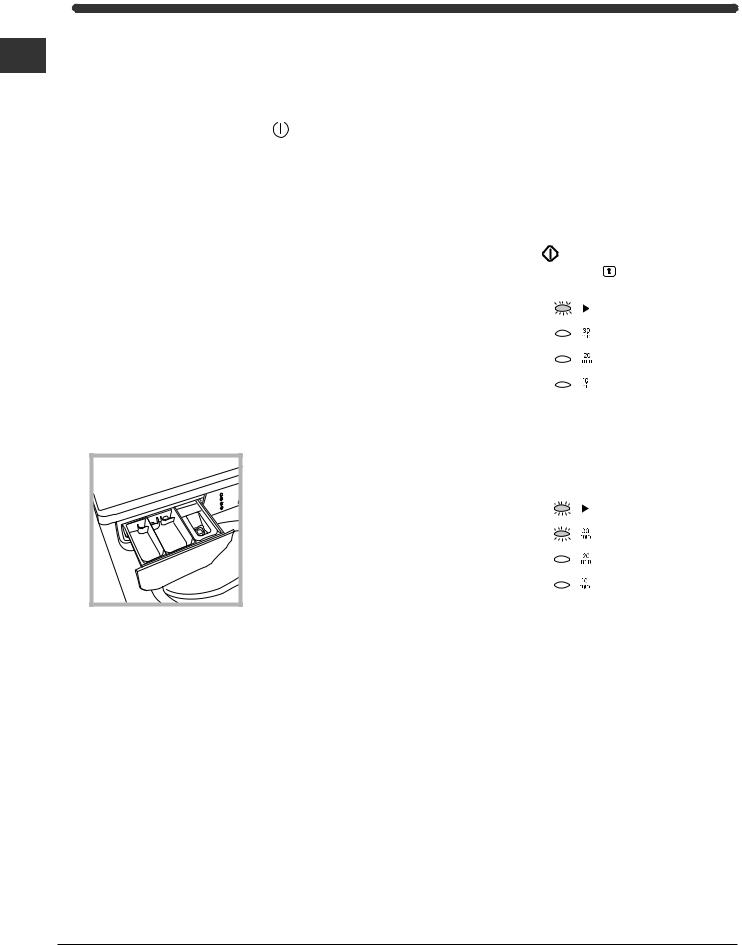
Come effettuare un ciclo di lavaggio
I |
Nota: Dopo l’installazione, prima dell’uso, effettua- |
|
re un ciclo di lavaggio con detersivo e senza bian- |
||
|
cheria impostando il programma  con manopola tempi in posizione “auto”.
con manopola tempi in posizione “auto”.
1. ACCENDERE LA MACCHINA premendo il pulsante ACCENSIONE SPEGNIMENTO . Tutte le spie si accenderanno per qualche secondo, poi si spengono e la spia ACCENSIONE/OBLÒ BLOCCATO
 inizierà a lampeggiare.
inizierà a lampeggiare.
2.CARICARE LA BIANCHERIA. Aprire l’oblò. Caricare la biancheria, facendo attenzione a non superare la quantità di carico indicata nella tabella programmi della pagina successiva.
3.DOSARE IL DETERSIVO/ADDITIVI
Estrarre completamente il cassetto e versare il detersivo nella vaschetta contrassegnata con il numero 2. Se si desidera, versare ammorbidente e altri additivi nel comparto 3. L’ammorbidente non deve fuoriuscire dalla griglia. Se si desidera
effettuare il programma di lavaggio dedicato all'abbigliamento sportivo  , impostando la manopola tempi sulla posizione “auto” o su una delle posizioni comprese fra “3h e 24h” (vedi “Detersivi e biancheria”) è inoltre possibile inserire detersivo in polvere per il prelavaggio nel comparto 1.
, impostando la manopola tempi sulla posizione “auto” o su una delle posizioni comprese fra “3h e 24h” (vedi “Detersivi e biancheria”) è inoltre possibile inserire detersivo in polvere per il prelavaggio nel comparto 1.
|
3 |
1 |
2 |
4. CHIUDERE L’OBLO’. |
|
5.SCEGLIERE IL TESSUTO DI LAVAGGIO ruotando la MANOPOLA PROGRAMMI verso destra o verso sinistra fino a selezionare il tessuto desiderato o il programma “Risciacquo”.
6.IMPOSTARE IL TEMPO DI FINE LAVAGGIO ruotando la MANOPOLA TEMPI verso destra o verso sinistra.
Sono possibili le seguenti impostazioni:
-Posizioni “30 min – 45 min – 60 min”: impostando uno di questi tempi si definisce la durata del programma selezionato.
-Posizioni da “3h” a “24h”: impostando uno di questi tempi si definisce dopo quante ore il programma di lavaggio dovrà terminare. La durata effettiva del lavaggio è pari a quella del ciclo "auto" (vedi tabella programmi nella pagina successiva), ma la macchina ritarderà automatica-
mente la partenza del ciclo per garantirne la conclusione nel tempo prefissato.
- Qualora non sia necessario impostare uno specifico tempo di fine lavaggio, selezionare la posizione AUTO: la macchina gestirà automaticamente la durata del programma in base al tessuto selezionato (vedi tabella programmi nella pagina
successiva).
Indipendentemente dalla posizione selezionata sulla MANOPOLA TEMPI, il programma “Risciacquo”  dura 15 minuti e parte immediatamente alla pressione del pulsante AVVIO/ANNULLA
dura 15 minuti e parte immediatamente alla pressione del pulsante AVVIO/ANNULLA  .
.
7. AVVIARE IL PROGRAMMA premendo il pulsante AVVIO/ANNULLA . Si illumineranno fisse le spie “accensione/oblò bloccato”  e “programma in corso”
e “programma in corso”  .
.
Durante il ciclo, le spie forniscono l’indicazione del tempo mancante al termine.
Quando mancheranno rispettivamente 30, 20 e 10 minuti alla fine del programma, le relative spie si illumineranno.
8.FINE DEL PROGRAMMA
Al termine del programma di lavaggio, tutte le spie
si spegneranno. Attendere lo sblocco dell’oblò (spia “accensione/oblò bloccato”  lampeggiante), estrarre la biancheria e lasciare l’oblò socchiuso per far asciugare il cestello. Spegnere la
lampeggiante), estrarre la biancheria e lasciare l’oblò socchiuso per far asciugare il cestello. Spegnere la
macchina premendo il pulsante ACCENSIONE/ SPEGNIMENTO  .
.
18

Tabella dei programmi
|
|
|
|
|
|
|
|
|
|
|
|
|
|
|
|
|
|
|
|
|
|
|
|
|
Natura dei tessuti |
|
|
|
|
Carico |
Temperatura |
|
|
|
I |
|
Programmi |
Tempi |
Max. |
Descrizione del ciclo di lavaggio |
|
||||||
|
e dello sporco |
|
|
|
|
(Kg) |
Max. |
|
|
|
|
|
|
|
|
|
|
|
|
|
|
|
|
|
|
|
|
|
auto (125 min.) |
4,5 |
60° |
|
|
|
|
|
|
|
|
|
|
|
|
|
|
|
|
|
|
|
|
|
30 min. |
3 |
40° |
|
|
|
|
|
Cotone bianchi |
|
|
|
45 min. |
3 |
60° |
Lavaggio, risciacqui, centrifughe intermedie e finale |
|
|
|
|
|
|
|
|
60 min. |
3 |
60° |
|
|
|
|
|
|
|
|
|
3h - 24h |
4,5 |
60° |
|
|
|
|
|
|
|
|
|
|
|
|
|
|
|
|
|
|
|
|
|
auto (70 min.) |
4,5 |
|
|
|
|
|
|
|
|
|
|
|
|
|
|
|
|
|
|
|
|
|
|
30 min. |
3 |
|
|
|
|
|
|
Cotone colorati |
|
|
|
45 min. |
3 |
40° |
Lavaggio, risciacqui, centrifughe intermedie e finale |
|
|
|
|
|
|
|
|
60 min. |
3 |
|
|
|
|
|
|
|
|
|
|
3h - 24h |
4,5 |
|
|
|
|
|
|
|
|
|
|
|
|
|
|
|
|
|
|
|
|
|
|
auto (60 min.) |
4,5 |
|
|
|
|
|
|
|
|
|
|
|
|
|
|
|
|
|
|
|
|
|
|
30 min. |
3 |
|
|
|
|
|
|
Cotone scuri/delicati |
|
|
|
45 min. |
3 |
30° |
Lavaggio, risciacqui, centrifughe intermedie e finale |
|
|
|
|
|
|
|
|
60 min. |
3 |
|
|
|
|
|
|
|
|
|
|
3h - 24h |
4,5 |
|
|
|
|
|
|
|
|
|
|
|
|
|
|
|
|
|
|
|
|
|
|
auto (60 min.) |
2,5 |
|
|
|
|
|
|
|
|
|
|
|
|
|
|
|
|
|
|
|
|
|
|
30 min. |
1,5 |
|
|
|
|
|
|
Sintetici |
|
|
|
45 min. |
2,5 |
40° |
Lavaggio, risciacqui, centrifuga delicata |
|
|
|
|
|
|
|
|
60 min. |
2,5 |
|
|
|
|
|
|
|
|
|
|
3h - 24h |
2,5 |
|
|
|
|
|
|
|
|
|
|
|
|
|
|
|
|
|
|
|
|
|
|
auto (60 min.) |
1 |
|
|
|
|
|
|
|
|
|
|
|
|
|
|
|
|
|
|
|
|
|
|
30 min. |
1 |
|
|
|
|
|
|
Lana |
|
|
|
45 min. |
1 |
40° |
Lavaggio, risciacqui, centrifuga delicata |
|
|
|
|
|
|
|
|
60 min. |
1 |
|
|
|
|
|
|
|
|
|
|
3h - 24h |
1 |
|
|
|
|
|
|
|
|
|
|
|
|
|
|
|
|
|
|
|
|
|
|
auto (60 min.) |
1 |
|
|
|
|
|
|
|
|
|
|
|
|
|
|
|
|
|
|
|
|
|
|
30 min. |
1 |
|
|
|
|
|
|
Delicati |
|
|
|
45 min. |
1 |
30° |
Lavaggio, risciacqui e scarico |
|
|
|
|
|
|
|
|
60 min. |
1 |
|
|
|
|
|
|
|
|
|
|
3h - 24h |
1 |
|
|
|
|
|
|
|
|
|
|
|
|
|
|
|
|
|
|
|
|
|
|
auto (60 min.) |
1,5 |
|
|
|
|
|
|
|
|
|
|
|
|
|
|
|
|
|
|
|
|
|
|
30 min. |
1,5 |
|
|
|
|
|
|
|
|
|
|
|
|
|
|
|
||
|
Special Sport |
|
|
|
45 min. |
1,5 |
30° |
Prelavaggio, lavaggio, risciacqui, centrifughe intermedie e finale |
|
|
|
|
|
|
|
|
|
|
|||||
|
|
|
|
|
60 min. |
1,5 |
|
|
|
|
|
|
|
|
|
|
3h - 24h |
1,5 |
|
|
|
|
|
|
|
|
|
|
|
|
|
|
|
|
|
|
Risciacquo |
|
|
|
* |
4,5 |
|
Risciacqui e centrifuga |
|
|
|
|
|
|
|
|
|
|
|
|
|
|
|
* Nota: indipendentemente dalla posizione della “manopola TEMPI”, il Risciacquo partirà immediatamente alla pressione del pulsante AVVIO/ANNULLA e durerà 15 minuti.
e durerà 15 minuti.
Importante:
-i programmi rapidi “30 min.” e “45 min.” (indipendentemente dal tipo di tessuto) sono consigliati per rinfrescare capi poco sporchi in poco tempo.
-i programmi “60 min.” (indipendentemente dal tipo di tessuto) sono consigliati per lavare capi poco sporchi.
-i tempi non sono comprensivi dei 2 minuti di attesa a fine ciclo necessari allo sblocco dell’oblò.
19

Detersivi e biancheria
Preparare la biancheria
I
•Suddividere la biancheria secondo:
-il tipo di tessuto / il simbolo sull’etichetta.
-i colori: separare i capi colorati da quelli bianchi.
•Vuotare le tasche e controllare i bottoni.
•Non superare i valori di carico massimo indicati nella “Tabella dei programmi”.
Quanto pesa la biancheria?
1lenzuolo 400-500 gr.
1federa 150-200 gr.
1tovaglia 400-500 gr.
1accappatoio 900-1.200 gr.
1asciugamano 150-250 gr.
Capi particolari
Tende: piegarle e sistemarle dentro una federa o un sacchetto a rete. Lavarle da sole senza superare il mezzo carico. Utilizzare il programma  che esclude in automatico la centrifuga.
che esclude in automatico la centrifuga.
Piumini e giacche a vento: se l’imbottitura è d’oca o d’anatra si possono lavare nella macchina. Rivoltare i capi e fare un carico massimo di 3 kg, ripetendo il risciacquo una o due volte.
Lana: per ottenere i migliori risultati utilizzare un detersivo specifico e non superare 1kg di carico.
Abbigliamento sportivo: utilizzare il programma “Special Sport”  . E' possibile effettuare una fase iniziale di prelavaggio, utile soprattutto per rimuovere residui di terra o fango dai capi. Per effettuarla, inserire detersivo in polvere nel comparto 1 del cassetto dei detersivi (vedi “Descrizione della mac-
. E' possibile effettuare una fase iniziale di prelavaggio, utile soprattutto per rimuovere residui di terra o fango dai capi. Per effettuarla, inserire detersivo in polvere nel comparto 1 del cassetto dei detersivi (vedi “Descrizione della mac-
china”).
La fase di prelavaggio non sarà effettuata se sulla manopola tempi è impostata una durata compresa fra 30 min e 1h.
Sistema bilanciamento del carico
Per evitare vibrazioni eccessive prima di ogni centrifuga la macchina distribuisce il carico in modo uniforme, questo avviene effettuando delle rotazioni continue del cesto ad una velocità leggermente superiore a quella di lavaggio.
Quando nonostante ripetuti tentativi il carico non viene perfettamente distribuito, la macchina effettua la centrifuga ad una velocità inferiore a quella prevista.
In presenza di eccessivo sbilanciamento la macchina effettua la distribuzione al posto della centrifuga.
Gli eventuali tentativi di bilanciamento possono allungare la durata totale del ciclo fino ad un massimo di 10 minuti.
20

Precauzioni e consigli
Questa macchina è stata progettata e costruita in conformità alle norme internazionali di sicurezza. Queste avvertenze sono fornite per ragioni di sicurezza e devono essere lette attentamente.
Sicurezza generale
•Questo apparecchio è stato concepito esclusivamente per un uso di tipo domestico.
•La macchina deve essere usata solo da persone adulte e secondo le istruzioni riportate in questo libretto.
•Non toccare la macchina a piedi nudi o con le mani o i piedi bagnati o umidi.
•Non staccare la spina dalla presa della corrente tirando il cavo, bensì afferrando la spina.
•Non aprire il cassetto dei detersivi mentre la macchina è in funzione.
•Non toccare l’acqua di scarico, che può raggiungere temperature elevate.
•Non forzare in nessun caso l’oblò: potrebbe danneggiarsi il meccanismo di sicurezza che protegge da aperture accidentali.
•In caso di guasto, in nessun caso accedere ai meccanismi interni per tentare una riparazione.
•Controllare sempre che i bambini non si avvicinino alla macchina in funzione.
•Durante il lavaggio l’oblò tende a scaldarsi.
•Se dev’essere spostata, lavorare in due o tre persone con la massima attenzione. Mai da soli perché la macchina è molto pesante.
•Prima di introdurre la biancheria controlla che il cestello sia vuoto.
Smaltimento
•Smaltimento del materiale di imballaggio: attenersi alle norme locali, così gli imballaggi potranno essere riutilizzati.
•La direttiva Europea 2002/96/CE sui rifiuti di apparecchiature elettriche ed elettroniche, prevede che gli elettrodomestici non debbano essere smaltiti nel normale flusso dei rifiuti solidi urbani. Gli apparecchi dismessi devono essere raccolti
separatamente per ottimizzare il tasso di recupero
e riciclaggio dei materiali che li compongono ed I impedire potenziali danni per la salute e l'ambiente.
Il simbolo del cestino barrato è riportato su tutti i prodotti per ricordare gli obblighi di raccolta separata.
Per ulteriori informazioni, sulla corretta dismissione degli elettrodomestici, i detentori potranno rivolgersi al servizio pubblico preposto o ai rivenditori.
Risparmiare e rispettare l’ambiente
Tecnologia a servizio dell’ambiente
Se nell’oblò si vede poca acqua è perché con la nuova tecnologia Indesit basta meno della metà dell’acqua per raggiungere il massimo pulito: uno scopo raggiunto per rispettare l’ambiente.
Risparmiare detersivo, acqua, energia e tempo
•Per non sprecare risorse bisogna utilizzare la macchina con il massimo carico. Un carico pieno al posto di due mezzi fa risparmiare fino al 50% di energia.
•Trattando le macchie con uno scioglimacchia o lasciandole in ammollo prima del lavaggio, si riduce la necessità di lavare ad alte temperature.
•Dosare bene il detersivo in base alla durezza dell’acqua, al grado di sporco e alla quantità di biancheria evita sprechi e protegge l’ambiente: pur biodegradabili, i detersivi contengono elementi che alterano l’equilibrio della natura. Inoltre evitare il più possibile l’ammorbidente.
•Effettuando i lavaggi dal tardo pomeriggio fino alle prime ore del mattino si collabora a ridurre il carico di assorbimento delle aziende elettriche.
21
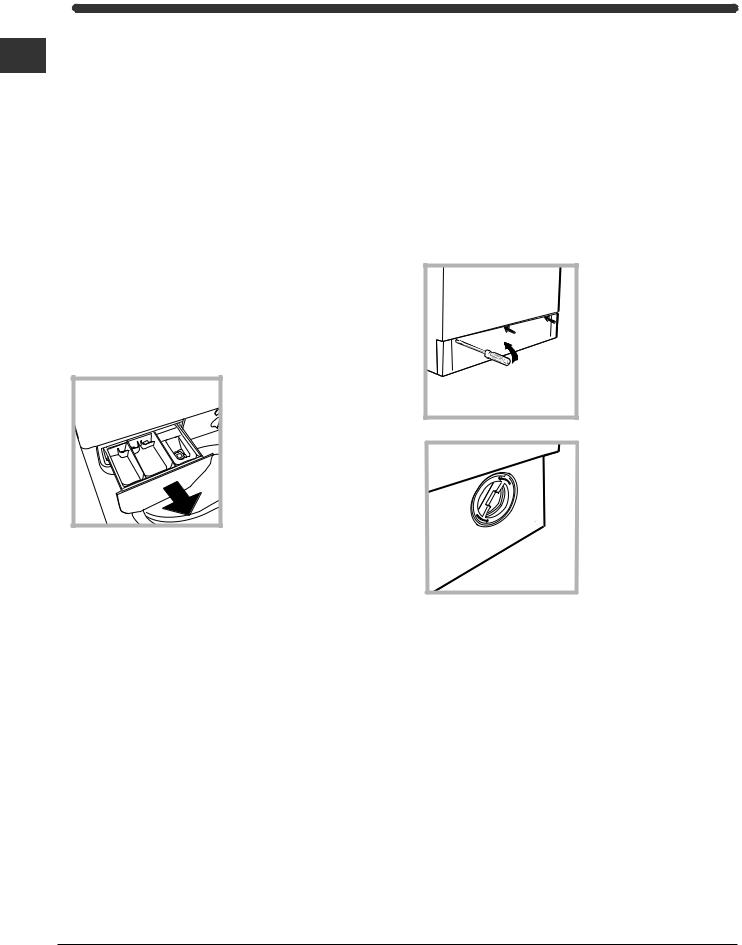
Manutenzione e cura
Escludere acqua e corrente elettrica
I
•Chiudere il rubinetto dell’acqua dopo ogni lavaggio. Si limita così l’usura dell’impianto idraulico della macchina e si elimina il pericolo di perdite.
•Staccare la spina della corrente quando si pulisce la macchina e durante i lavori di manutenzione.
Pulire la pompa
La macchina è dotata di una pompa autopulente che non ha bisogno di manutenzione. Può però succedere che piccoli oggetti (monete, bottoni) cadano nella precamera che protegge la pompa, situata nella parte inferiore di essa.
Assicurarsi che il ciclo di lavaggio sia terminato e staccare la spina.
Pulire la macchina |
Per accedere alla precamera: |
La parte esterna e le parti in gomma possono essere puliti con un panno imbevuto di acqua tiepida e sapone. Non usare solventi o abrasivi.
Pulire il cassetto dei detersivi
Sfilare il cassetto sollevandolo e tirandolo verso l’esterno (vedi figura). Lavarlo sotto l’acqua corrente; questa pulizia va effettuata frequentemente.
Curare oblò e cestello
•Lasciare sempre socchiuso l’oblò per evitare che si formino cattivi odori.
1. rimuovere il pannello di copertura sul lato anteriore della macchina con l’ausilio di un giravite (vedi figura);
2. svitare il coperchio ruotandolo in senso antiorario (vedi figura): è normale che fuoriesca un po’ d’acqua;
3.pulire accuratamente l’interno;
4.riavvitare il coperchio;
5.rimontare il pannello assicurandosi, prima di spingerlo verso la macchina, di aver inserito i ganci nelle apposite asole.
Controllare il tubo di alimentazione dell’acqua
Controllare il tubo di alimentazione almeno una volta all’anno. Se presenta screpolature e fessure va sostituito: durante i lavaggi le forti pressioni potrebbero provocare improvvise spaccature.
Non utilizzare mai tubi già usati.
22
